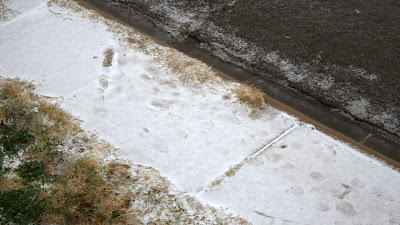As a scientist (inspired by Coldplay's song with the same name), you observe. I remember back on February, 2011 when we had a few flurries in Monterrey, (as well as the coldest air in many years, that was when Dallas hosted the Superbowl under a heavy snow blanket) and wondered why was snow not accumulating if it was below freezing. All I could think of was that the ground stayed above freezing. Was it the sun and the dry ground?
Almost two years later, we get hit with two different ice storms (with a little snow mixed in) in late November and early December in Odessa, Texas. Both winter storms brought below freezing temperatures for more than 72 hours in a row.
Back in November, ice began coating cars, trees, grass, and shrubs right away, but it was not until the second day after the sun had set that streets began to ice. During this time, the temperatures were nearly steady in the upper 20s (-1˚C or -2˚C), but part of the ice melted during the day even though it was cloudy. Why?
Last week was not as icy, however, temperatures reached the teens and the lower 20s (-6˚C to -9˚C) during the daytime, and ice did not melt. It was cloudy as well.
The sun heats the ground and then the ground heats the air above it. So, apparently, what keeps the snow from accumulating and what keeps the ice melting during the daytime, when temperatures are below freezing is the sun's radiation. That must be the reason why the ground gets very hot on a summer day. Eventually it can get cold enough to keep the snow or the ice from melting despite the sun's rays. I know that under cloudy skies, snow and ice should not thaw if it is -6˚C or less. Would this happen on a sunny day too? That remains to be seen.














